NRCS award a huge boost for ambitious project to restore threatened river
(Kremmling)—The U.S. Department of Agriculture’s Natural Resources Conservation Service (NRCS) today announced $7.75 million in funding for an ambitious slate of projects to address the impacts on the Colorado River of trans-mountain diversions of water from the West Slope to the Front Range. Fisheries conservation group Trout Unlimited is the lead partner on the grant application.
The Colorado River Headwaters Project received $7,758,830 from the NRCS’s Regional Conservation Partnership Program (RCPP) to improve irrigation systems and reverse the decline in water quality and fish habitat in the headwaters of the Colorado River.
 Led by an array of partners representing conservation interests, agriculture, local government, water providers, state agencies, and landowners, the Headwaters Project will create a bypass channel to reconnect the Colorado River at Windy Gap Reservoir, make channel and habitat improvements downstream of the bypass near Kremmling, Colorado, and improve irrigation systems as well as soil and water quality.
Led by an array of partners representing conservation interests, agriculture, local government, water providers, state agencies, and landowners, the Headwaters Project will create a bypass channel to reconnect the Colorado River at Windy Gap Reservoir, make channel and habitat improvements downstream of the bypass near Kremmling, Colorado, and improve irrigation systems as well as soil and water quality.
When fully implemented, the Headwaters Project will directly benefit more than 30 miles of the Colorado River and 4,500 acres of irrigated lands that provide sage grouse habitat and make available up to 11,000 acre-feet of water to improve the river during low-flow conditions.
“This is a huge win for the Colorado River,” said Drew Peternell, director of Trout Unlimited’s Colorado Water Project. “We’re seeing an exciting and ambitious conservation vision for the upper Colorado become reality. With this funding, we’ll be able to put the ecosystem pieces of the upper Colorado River back together and restore the river and its trout fishery to health.”
“The Colorado River Headwaters Project is a great example of how municipal water providers, ranchers, conservation organizations and others can work together to restore an important reach the Colorado River for both the environment and agricultural operations with benefits downstream,” said Matt Rice, director of American River’s Colorado River Basin Program. “A collaboration like this would have been unheard of 10 years ago. It’s a win for everyone in Colorado.”
At present, transmountain diversions divert over 60 percent of the upper Colorado River’s native flows across the Continental Divide for use in the Front Range and northern Colorado. The resulting low flows in the river have seriously undermined the operations of irrigation systems and the health of the Colorado River in the project area. Low flows make it difficult for irrigators to divert water, especially during drought, and also raise water temperatures and hamper the river’s ability to transport sediment, leading to sediment buildup on the riverbed that degrades aquatic habitat.
Local ranchers wanted to address these irrigation problems as well as river health, said Paul Bruchez, a Kremmling-area rancher who organized his neighboring landowners into the Irrigators of Land in Vicinity of Kremmling (ILVK) group, a key project partner. The project will install several innovative instream structures designed to provide adequate water levels for irrigation while also improving critical fish habitat. This will be the first project in the country to demonstrate these stream engineering practices on a significant scale.
“This news is life-changing for the headwaters of the Colorado River and those who rely on it,” said Bruchez. “Years ago, water stakeholders in this region were at battle. Now, it is a collaboration that will create resiliency and sustainability for the health of the river and its agricultural producers. Healthy ranches need healthy rivers, and the RCPP funding will help sustain both.”
The Windy Gap Reservoir bypass and the Kremmling area river improvements address several pieces of the puzzle in a long-term, regional effort to restore the upper Colorado River. Other pieces include agreements that TU helped negotiate with Denver Water and the Northern Colorado Water District that contained significant river protections as well as an innovative, long-term monitoring and adaptive management process (called “Learning by Doing”) that requires stakeholders to work together to ensure the future health of the river. That progress and collaboration is all the more remarkable coming after years of conflict between West Slope interests and conservation groups concerned about the health of the river, and Front Range water providers seeking to divert more water across the Divide.
“What’s happening on the upper Colorado shows that water users can work together to ensure river health while meeting diverse uses,” said TU’s Peternell. “This project is a model of what cooperation and collaboration can achieve in meeting our water challenges in Colorado and the Colorado River Basin.”
Other Headwaters Project partners who will provide assistance include the ILVK, Northern Water Conservation District, Denver Water, Colorado River Conservation District, Middle Park Soil Conservation District, Colorado Water Conservation Board, Grand County, and Colorado Parks and Wildlife.
Trout Unlimited is the nation’s largest coldwater conservation organization, with 147,000 members dedicated to conserving, protecting, and restoring North America’s trout and salmon fisheries and their watersheds. Colorado Trout Unlimited has more than 10,000 grassroots members across the state.
American Rivers protects wild rivers, restores damaged rivers, and conserves clean water for people and nature.






 Back in the 1960’s planners thought that Aspen’s population (1,101 in 1960) would reach 30,000 by the end of the century and that additional water supplies would be necessary. Aspen’s population didn’t grow much. In 2000 it was up to 5,914 and by 2010 had added less than a thousand more. Looking forward, the City’s population isn’t expected to grow much more over the next 60 years either, yet Aspen continues to hang on to the notion that they might, someday, need these destructive dams and reservoirs.
Back in the 1960’s planners thought that Aspen’s population (1,101 in 1960) would reach 30,000 by the end of the century and that additional water supplies would be necessary. Aspen’s population didn’t grow much. In 2000 it was up to 5,914 and by 2010 had added less than a thousand more. Looking forward, the City’s population isn’t expected to grow much more over the next 60 years either, yet Aspen continues to hang on to the notion that they might, someday, need these destructive dams and reservoirs.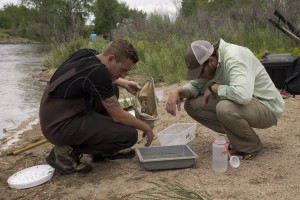
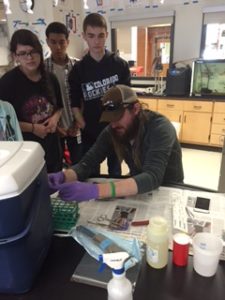 In Colorado, there are currently six active tanks involved with the TIC program. These classrooms are located all over Colorado. CTU helps these classrooms by assisting in obtaining trout eggs, coordinating supplies, and helping with the required disease testing prior to the release.
In Colorado, there are currently six active tanks involved with the TIC program. These classrooms are located all over Colorado. CTU helps these classrooms by assisting in obtaining trout eggs, coordinating supplies, and helping with the required disease testing prior to the release.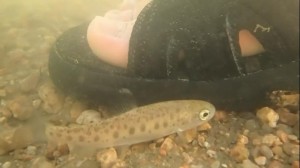 Parents have also gotten into the fun through TIC. "While the program is targeted at the kids, the teachers involved have noted that many of the parents have been excited about the tanks as well, not only keeping up with the egg/fry progress through their children, but visiting the tanks during parent-teacher conferences, involving the whole family in the educational process," said Bloodworth.
Parents have also gotten into the fun through TIC. "While the program is targeted at the kids, the teachers involved have noted that many of the parents have been excited about the tanks as well, not only keeping up with the egg/fry progress through their children, but visiting the tanks during parent-teacher conferences, involving the whole family in the educational process," said Bloodworth.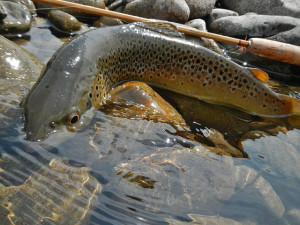 1. Use Yarn- many of you reading this may have heard this recommendation before, but it bears repeating. I feel that strongly about it. Simply put, yarn indicators are WAY more sensitive than plastic bobber-style indicators. Fish this time of year can be pretty lethargic (compared to summer) and typically won’t eat your flies with much aggression. Oftentimes your yarn won’t even dunk underwater but rather just ‘pause’ or ‘lean over’ when a fish strikes. If you’ve never used yarn indicators before, be prepared to be amazed with the sensitivity you’ll get. Side note- tips for yarn success- carry several and liberally apply some fly floatant before starting the day. Be prepared to dry off your indicator every couple hours and reapply. If you decide that your indicator is too waterlogged after a few hours, simply swap it out for a fresh one. While I realize these do require a little more maintenance than a thingamabobber, the fact that it leads to more fish in the net throughout the day is always worth it to me.
1. Use Yarn- many of you reading this may have heard this recommendation before, but it bears repeating. I feel that strongly about it. Simply put, yarn indicators are WAY more sensitive than plastic bobber-style indicators. Fish this time of year can be pretty lethargic (compared to summer) and typically won’t eat your flies with much aggression. Oftentimes your yarn won’t even dunk underwater but rather just ‘pause’ or ‘lean over’ when a fish strikes. If you’ve never used yarn indicators before, be prepared to be amazed with the sensitivity you’ll get. Side note- tips for yarn success- carry several and liberally apply some fly floatant before starting the day. Be prepared to dry off your indicator every couple hours and reapply. If you decide that your indicator is too waterlogged after a few hours, simply swap it out for a fresh one. While I realize these do require a little more maintenance than a thingamabobber, the fact that it leads to more fish in the net throughout the day is always worth it to me.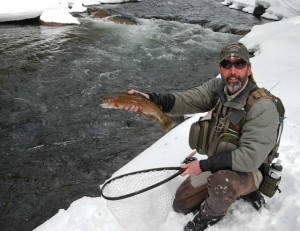 Whenever you approach a likely looking area, always make it a point to fish it while keeping your wading boots on dry ground. Avoiding splashing around, crunching rocks, and in general- disturbing the water with your steps- is always going to leave the fish feeling much more at ease and in turn- more eager to eat your flies (this rule should actually be applied year round).
Whenever you approach a likely looking area, always make it a point to fish it while keeping your wading boots on dry ground. Avoiding splashing around, crunching rocks, and in general- disturbing the water with your steps- is always going to leave the fish feeling much more at ease and in turn- more eager to eat your flies (this rule should actually be applied year round).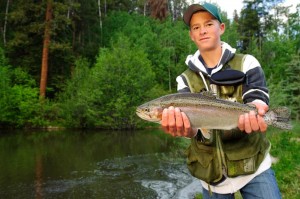 5. Watch the bubbles- we’ve already talked about indicators and weight, and I firmly believe that one of the biggest reasons people don’t catch as many fish as they should is that they’re simply not getting down to them. Next time your nymphing make sure to keep an eye on the bubbles on the surface. What are they doing? Are they moving the same speed as your indicator? If so, this is a dead giveaway you’re not getting down to the fish. Most fish this time of year are sitting very close to the bottom. The water on the bottom of the river is moving slower than the water on the surface. If you’re indicator is floating the same speed as the bubbles on the surface, this means that you’re not getting down to the fish. Simple as that. The goal is to always have your indicator floating SLOWER than the bubbles on the surface. This can quickly be achieved by adding a little more depth and/or weight to your rig. If you’ve never paid attention to this before I think you’ll be amazed at how much of a difference it makes and how quickly you are now able to dial in your rig, ultimately achieving a perfect drift to the fish!
5. Watch the bubbles- we’ve already talked about indicators and weight, and I firmly believe that one of the biggest reasons people don’t catch as many fish as they should is that they’re simply not getting down to them. Next time your nymphing make sure to keep an eye on the bubbles on the surface. What are they doing? Are they moving the same speed as your indicator? If so, this is a dead giveaway you’re not getting down to the fish. Most fish this time of year are sitting very close to the bottom. The water on the bottom of the river is moving slower than the water on the surface. If you’re indicator is floating the same speed as the bubbles on the surface, this means that you’re not getting down to the fish. Simple as that. The goal is to always have your indicator floating SLOWER than the bubbles on the surface. This can quickly be achieved by adding a little more depth and/or weight to your rig. If you’ve never paid attention to this before I think you’ll be amazed at how much of a difference it makes and how quickly you are now able to dial in your rig, ultimately achieving a perfect drift to the fish!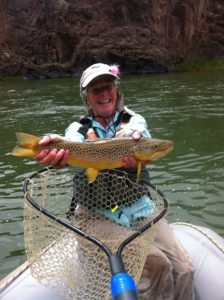 Why did you become a member and what chapter are you involved with?
Why did you become a member and what chapter are you involved with?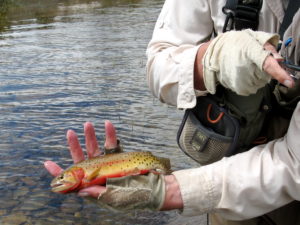
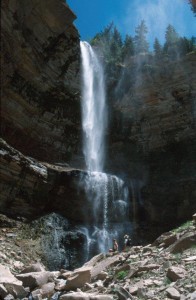

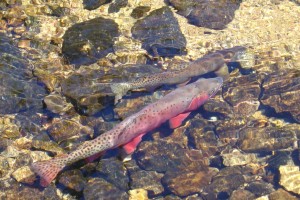
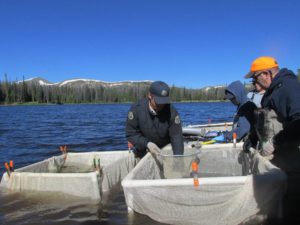 Colorado TU teamed up with Colorado Parks and Wildlife to reintroduce Greenback Cutthroat trout into their native watersheds all along the Front Range. Efforts this past year including spawning
Colorado TU teamed up with Colorado Parks and Wildlife to reintroduce Greenback Cutthroat trout into their native watersheds all along the Front Range. Efforts this past year including spawning 
